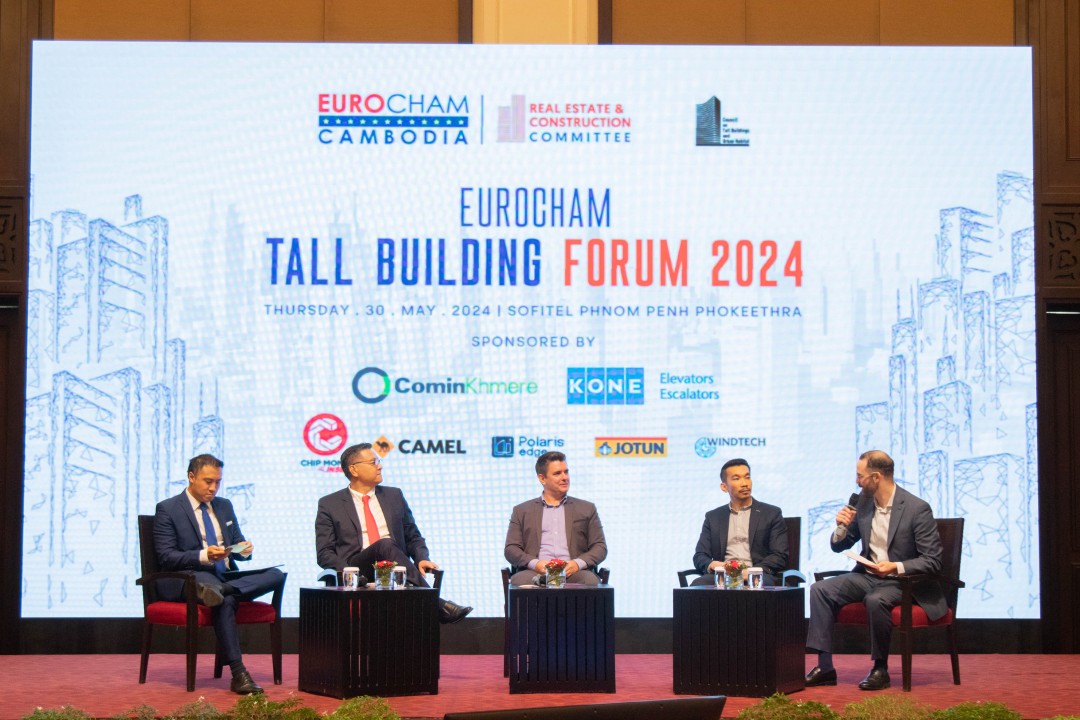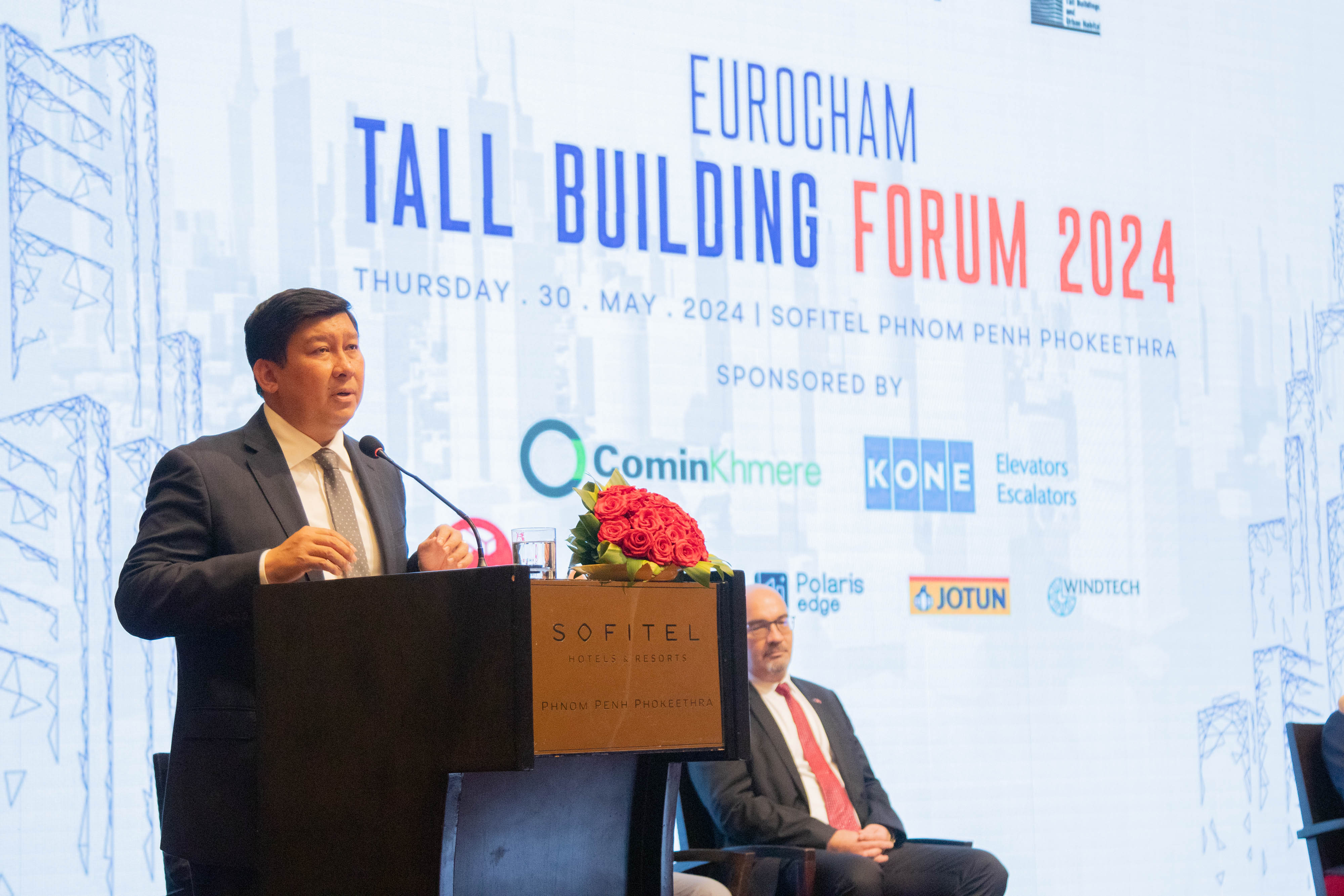EuroCham’s Tall Building Forum 2024 Explores The Future Of Skyscrapers

EuroCham Cambodia’s Real Estate and Construction Committee, in partnership with the Construction Committee of EuroCham Vietnam, hosted its third successful edition of the ‘Tall Building Forum’ at Sofitel Phnom Penh Phokeethra on Thursday May 30, 2024.
The chamber committee's flagship forum brought together influential players in the sector from around the region for insightful discussions on the evolving landscape of tall buildings in Southeast Asia and featured a model exhibition created by students as part of the ‘Future Tall Building Competition’.
Among the themes explored during the forum was balancing the need for tall buildings due to urbanisation while ensuring local culture is kept intact and infrastructure is not overwhelmed. With a lack of zoning regulations and infrastructure such as drainage and road networks that are already strained, the country is at a crossroads where decisions today will decide the shape of Cambodia’s cities in the future.
H.E. Say Samal, Deputy Prime Minister and Minister of Land Management, Urban Planning and Construction in Cambodia, addressed the 140 gathered at Sofitel before lunch, saying it was crucial to start planning for a Phnom Penh that suits everyone at this critical stage of development.

He said:
We want a city where everyone can live, they can have their own niche where they can find a decent job, put food on the table, and their kids can go to a quality school. Everyone should have a say in how the city is designed and planned… our identity was lost during the Khmer Rouge, and we need to build it back ourselves. We stepped out of the foxhole and we’re building a new society, setting new values, and creating a new way of life.
In his opening remarks, EuroCham Chairman, Tassilo Brinzer, said, “The real estate and construction sector is going through a transition phase, but as this forum shows, there’s optimism and a renewed focus on better quality, better energy efficiency and increased sustainability overall for tall buildings and their surrounding infrastructures.”
Sreng Vannak, Chief of Administration at the Phnom Penh Capital Hall, said it’s important to consider local customs and the limited infrastructure capabilities when designing new buildings.
“Phnom Penh is an old city that’s developed into a high-rise city, we know that the public infrastructure needs to improve,” he said.
Vannak mentioned that the quick and drastic change creates challenges for the city to adapt, and typical high-rise lifestyles are often at odds with traditional Cambodian styles of accommodation. With a lack of zoning regulations, this means that oftentimes the surrounding areas of tall buildings are not designed for a sudden influx of cars or foot traffic, straining the local infrastructure.
Beton Block and Pave CEO Serge Pak said with proper planning, there are ways to continue to use tall buildings while improving the surrounding environment.
“Better use of land consumption leaves more room for green space, which is very engaging for the community. If we balance the high-rise development with the participation of the community, we’ll have successful development,” he said.
Watch a snippet of H.E. Say Samal's speech at the third edition of EuroCham's ‘Tall Building Forum’
Outgoing CBRE Managing Director Lawrence Lennon said he sees mixed-use potential in high-rises in places like Sihanoukville.
“I see potential for hospitals, education, and retirement living," he said. "Affordable housing should be a big opportunity in Sihanoukville, as well as universities. I think Cambodia needs to try to open its door to get an international university in Sihanoukville.”
Later in the afternoon, experts discussed the undiminished popularity of high-rises across the world, as they’re both a sign of strength and technical ingenuity and they’re highly practical to account for the urbanisation trend. By 2050, experts suggest up to 70 per cent of the global population will live in urban areas.
Mohammed Adib, Chief Design Officer at Dewan Architects & Engineers, said in the future, societies will be spending more time in smaller and denser areas. “You have your green spaces, nature, schools, and everything, and you work there. If you need to travel, there’s easy coordination with other areas like airports and surrounding towns.”
The forum ended with a look at emerging technology trends in the sector such as improved pre-fabrication builds, cutting-edge wind-resistant technology, and innovations in lifts and green roof spaces.
Benjamin Warner, Managing Director at RHSP, said a mix of high-rise and low-rise was the answer, creating a walkable environment that’s connected to the city and meshes well with the environment. Coordination with the public sector was key to the success of massive urban planning, he said.
“It requires strong and robust political intervention to do it, it’s not just about just master plans and architects, its about politicians that make this happen.”
This press release was supplied.